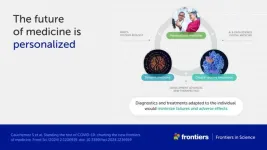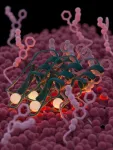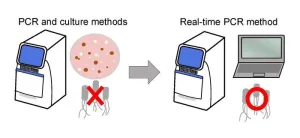(Press-News.org) Scientists have released the first set of scientific data captured with the Euclid telescope, showing an exciting glimpse of the Universe’s distant past.
The telescope, launched in July 2023, is part of the Dark Energy Satellite Mission, which aims to map the dark Universe.
Led by the European Space Agency in collaboration with The Euclid Consortium - which includes astronomers at The University of Manchester in leadership positions – the mission seeks to unlock mysteries of dark matter and dark energy and reveal how and why the Universe looks as it does today.
Early observations, described in a series of 10 scientific papers published today, include five never-before-seen images of the Universe.
The papers also describe several new discoveries including, free-floating new-born planets, newly identified extragalactic star clusters, new low-mass dwarf galaxies in a nearby galaxy cluster, the distribution of dark matter and intracluster light in galaxy clusters, and very distant bright galaxies from the first billion years of the Universe.
The findings give an insight into the unprecedented power of the Euclid telescope, which is designed to provide the most precise map of our Universe over time and demonstrates Euclid’s ability to unravel the secrets of the cosmos.
Chrisopher Conselice, Professor of Extragalactic Astronomy at The University of Manchester, said: “Euclid will completely revolutionise our view of the Universe. Already these results are revealing important new findings about local galaxies, new unknown dwarf galaxies, extrasolar planets and some of the first galaxies. These results are only the tip of the iceberg in terms of what will come. Soon Euclid will discover yet unknown details of the dark energy and give a full picture of how galaxy formation occurred across all cosmic time.”
Michael Brown, Professor of Astrophysics at The University of Manchester, added: “The exceptional data that Euclid is delivering over a large fraction of the sky promises to revolutionise our understanding of dark energy. It is extremely exciting to be part of the team working to extract these headline science results.”
The Early Release Observations programme was conducted during Euclid’s first months in space as a first look at the depth and diversity of science Euclid will provide. A total of 24 hours were allocated to target 17 specific astronomical objects, from nearby clouds of gas and dust to distant clusters of galaxies, producing stunning images that are invaluable for scientific research. In just a single day, Euclid produced a catalogue of more than 11 million objects in visible light and five million more in infrared light.
The images published today follow the return of the space telescope’s first full-colour images of the cosmos produced in November 2023.
In addition to contributions to the mission’s primary objectives, scientists at The University of Manchester, in collaboration with the University of Massachusetts Amherst, conducted a preliminary search of the data for distant galaxies. The red galaxies in the image show the cluster, which acts as a magnifying glass to reveal more distant sources behind. In total, 29 galaxies were discovered providing insight into the first billion years of the Universe.
Dr Rebecca Bowler, Ernest Rutherford Fellow at The University of Manchester, said: “In these spectacular images we can see galaxies that were previously invisible, because the most distant galaxies can only be discovered using the longer near-infrared wavelengths seen by Euclid.
“This first look data has been invaluable to test our search algorithms and identifying challenges, such as confusion of distant galaxies with brown dwarfs in our own Milky Way, before we start working on the main data later this year.
“What is amazing is that these images cover an area of less than 1% of the full deep observations, showing that we expect to detect thousands of early galaxies in the next few years with Euclid, which will be revolutionary in understanding how and when galaxies formed after the Big Bang.”
The images obtained by Euclid are at least four times sharper than those that can be taken from ground-based telescopes. They cover large patches of sky at unrivalled depth, looking far into the distant Universe using both visible and infrared light.
The next data release from the Euclid Consortium will focus on Euclid’s primary science objectives. A first worldwide quick release is currently planned for March 2025, while a wider data release is scheduled for June 2026. At least three other quick releases and two other data releases are expected before 2031, which corresponds to a few months after the end of Euclid’s initial survey.
The Euclid Consortium comprises more than 2600 members, including over 1000 researchers from more than 300 laboratories in 15 European countries, plus Canada, Japan and United States, covering various fields in astrophysics, cosmology, theoretical physics, and particle physics.
Josef Aschbacher, ESA Director General, said: “Euclid demonstrates European excellence in frontier science and state-of-the-art technology, and showcases the importance of international collaboration.
“The mission is the result of many years of hard work from scientists, engineers and industry throughout Europe and from members of the Euclid scientific consortium around the world, all brought together by ESA. They can be proud of this achievement – the results are no small feat for such an ambitious mission and such complex fundamental science. Euclid is at the very beginning of its exciting journey to map the structure of the Universe.”
END
Scientists reveal first data from Euclid telescope offering snapshot of cosmic history
2024-05-23
ELSE PRESS RELEASES FROM THIS DATE:
Big data, AI, and personalized medicine: scientists reveal playbook aiming to revolutionize healthcare
2024-05-23
What should the medicine of the future look like? A team of scientists writing in Frontiers in Science lays out a bold vision for precision approaches to understanding, preventing, and treating diseases, driven by revolutionary technologies and new interdisciplinary collaborations between researchers and other health sector professionals. The internationally renowned authors – led by Prof Michel Goldman, recipient of the Blaise Pascal Medal 2024 for his exceptional contributions to immunology and healthcare innovation, and leading microbiologist Prof Philippe Sansonetti from the Institut Pasteur and Collège ...
First ever survey of A&E triage nurses highlights problems with a lack of training, low staffing, high stress and overflowing departments
2024-05-23
Peer-reviewed - survey - people
Nurses who assess patients at emergency departments would like more training and say their decisions can be negatively impacted by the high pressures of their work.
Researchers at the University of East Anglia conducted the first ever UK survey of triage nurses to discover the background, training and decision-making processes of this role in emergency departments.
Lead author Hugh Gorick, a PhD researcher at UEA’s School of Health Sciences who also works as an assistant practitioner in an NHS hospital’s Acute Medical Unit, said: “More than 24 million patients present to emergency departments ...
The global clean water crisis looms large
2024-05-23
Water scarcity will intensify with climate and socioeconomic change, disproportionately impacting populations located in the Global South. So concludes a new Utrecht University article published in Nature Climate Change on 23 May 2024, which used a state-of-the-art global water quantity and quality model to estimate clean water scarcity until the end of the century.
Humans require clean water for drinking and sanitation purposes, but also for the production of food, energy and manufactured goods. As communities and policymakers grapple with water scarcity issues on the ground, researchers ...
Antibiotic ‘Velcro’ gives bacteria a sticky situation
2024-05-23
A small antibiotic called plectasin uses an innovative mechanism to kill bacteria. By assembling into large structures, plectasin latches onto its target on the bacterial cell surface comparable to how both sides of Velcro form a bond. A research team, led by structural biologist Markus Weingarth and biochemist Eefjan Breukink at Utrecht University, mapped how the Velcro-structure is formed. Their discovery, published in the scientific journal Nature Microbiology, unveils a new approach that could have broad implications for the development of antibiotics to ...
City of Hope researchers to present investigational treatments for colorectal, kidney and blood cancers at 2024 American Society of Clinical Oncology (ASCO) Annual Meeting
2024-05-23
LOS ANGELES — World-renowned physicians and researchers from City of Hope®, one of the largest cancer research and treatment organizations in the United States, will present new data and offer expert perspectives on leading-edge cancer research and treatments in development at the 2024 ASCO Annual Meeting, which will take place in Chicago from May 31 to June 4. Highlights include the following:
2024 Best of ASCO® program: New data on mismatched unrelated donor peripheral blood stem cell transplantation
Late-breaking data on the phase 3 CodeBreaK 300 trial
Glofitamab monotherapy for patients ...
Bigger is better: male proboscis monkeys’ enhanced noses evolved to attract mates
2024-05-23
When it comes to the animal kingdom, bigger is better. Well, at least for proboscis monkeys, famously known for their long, large and droopy noses.
Researchers from The Australian National University (ANU) have provided a world-first explanation for why male proboscis monkeys have larger and “enhanced” nasal structures.
The researchers examined the bony nasal cavity inside the skulls of proboscis monkeys and found their large noses are more than just an eye sore and in fact offer several major benefits, especially when ...
Early access to first-seizure clinics, subsequent outcomes, and factors associated with attendance
2024-05-23
About The Study: The results of this cohort study suggest that first-seizure clinic (FSC) attendance, particularly early attendance, was associated with reduced rates of subsequent hospital utilization. This knowledge may support adequately resourcing FSCs to improve equitable, timely access. Future study directions include assessing interventions that may support FSC attendance for at-risk groups.
Corresponding Author: To contact the corresponding author, Emma Foster, M.B.B.S.(Hons), Ph.D., email emma.foster@monash.edu.
To access the embargoed study: Visit our For The Media website at this link https://media.jamanetwork.com/
(doi:10.1001/jamaneurol.2024.1187)
Editor’s ...
How stores use TikTok to sell e-cigarettes to children
2024-05-23
A new paper in Nicotine and Tobacco Research, published by Oxford University Press, shows that advertising and sales of vaping products is common on TikTok, the video sharing platform popular among teenagers. Users pushing these items often use hashtags like #puffbundles to disguise vaping products by including things like lip gloss and candy in the packages for sale.
Despite smoking rates reaching an all-time low in the United States, public health professionals are concerned about adolescent use of electronic cigarettes. In 2023 some 4.7 million (17%) middle school and high school students ...
Mistaken identity cleared up of foodborne pathogen causing severe symptoms in children
2024-05-23
The prevalence of pathogenic E. coli has meant the frequent misidentification of a similar bacterium of the Escherichia genus. E. albertii is an emerging zoonotic foodborne pathogen, first isolated in Bangladesh in 1991. Large-scale outbreaks of food poisoning caused by E. albertii have since been reported especially in Japan, causing severe symptoms in both children and adults.
In the hopes of establishing a diagnostic method, a joint research group led by Professor Shinji Yamasaki and Dr. Sharda Prasad Awasthi, a specially appointed ...
Approximately one in nine U.S. children diagnosed with ADHD, as new national study highlights an “ever-expanding” public health concern
2024-05-23
An exploration into the national U.S. dataset on children ever diagnosed with ADHD has revealed an “ongoing and ever-expanding” public health issue.
Findings published in the peer-reviewed Journal of Clinical Child & Adolescent Psychology uncover that approximately one million more children, aged 3-17, had received an ADHD diagnosis in 2022 than in 2016.
The paper reveals around one in nine children have ever received an ADHD diagnosis – 11.4%, ...



